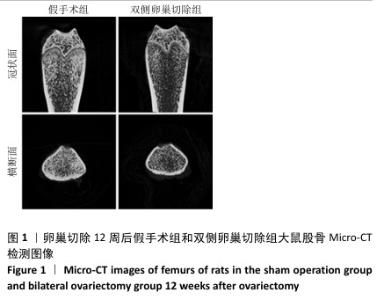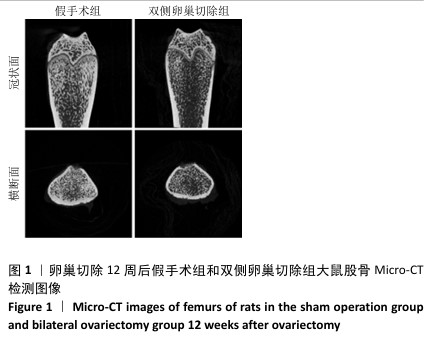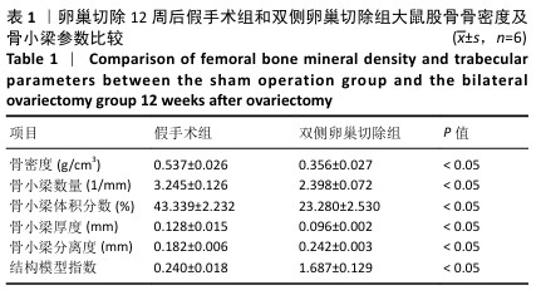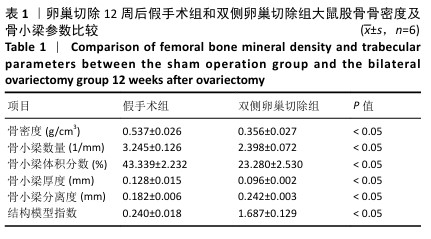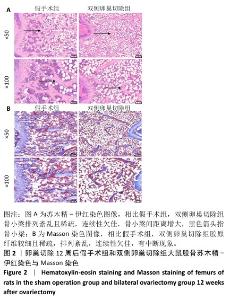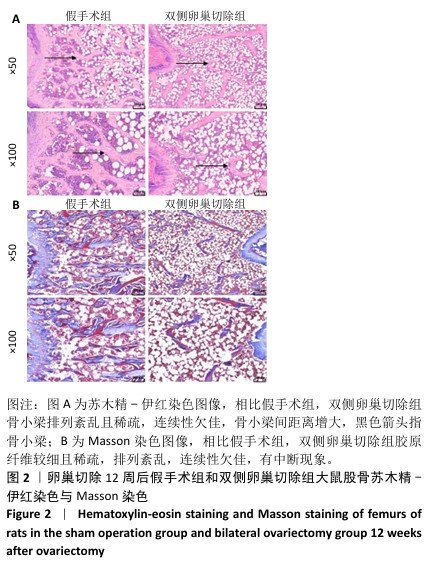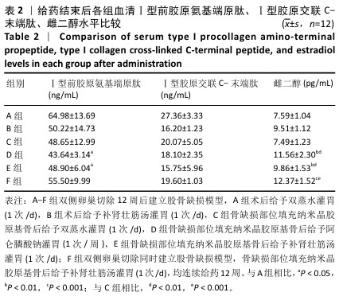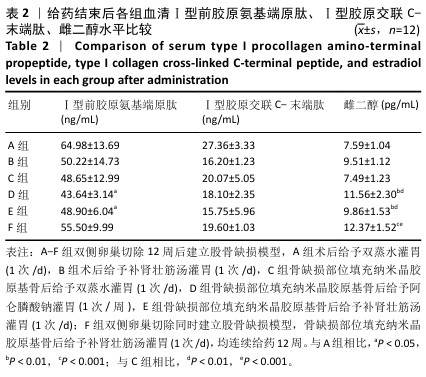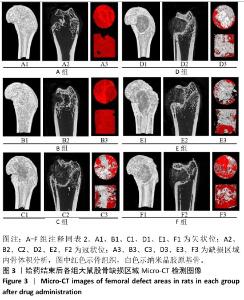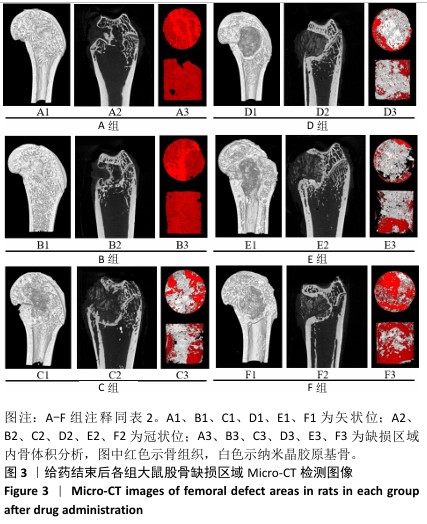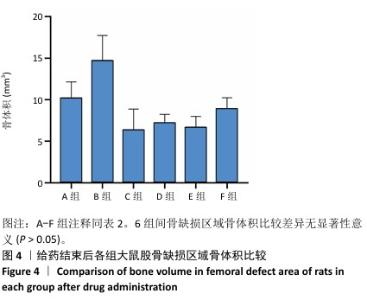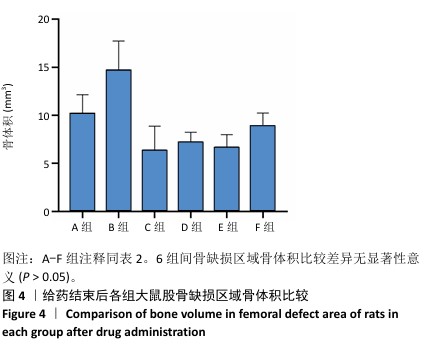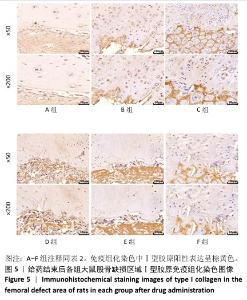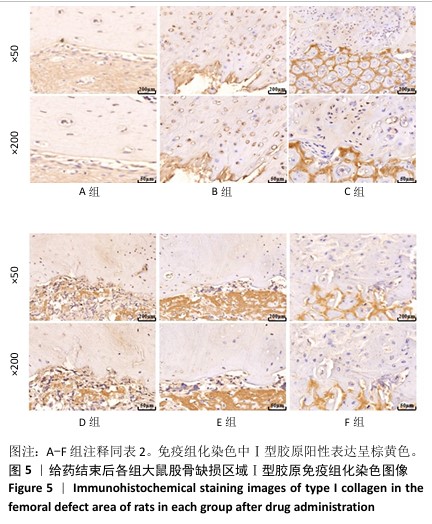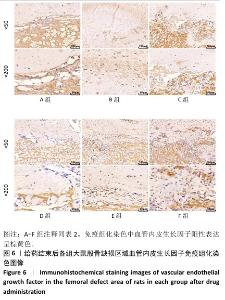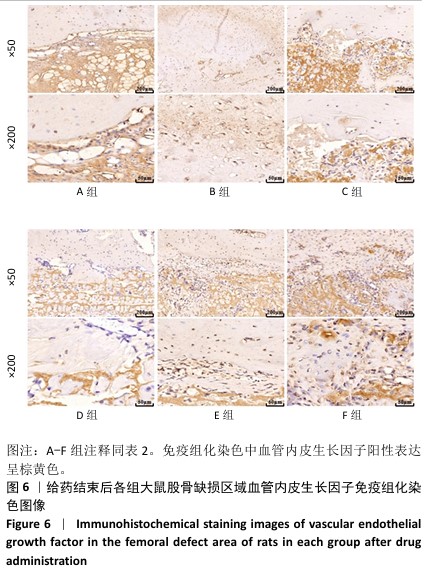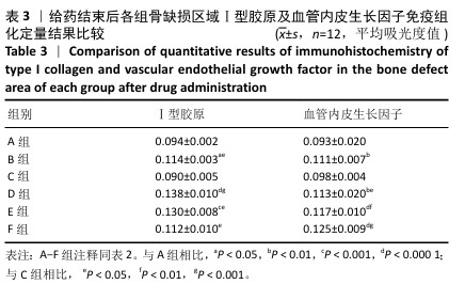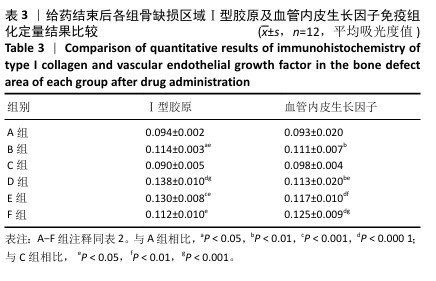Chinese Journal of Tissue Engineering Research ›› 2026, Vol. 30 ›› Issue (2): 354-361.doi: 10.12307/2026.546
Previous Articles Next Articles
Nanocrystalline collagen-based bone combined with Bushen Zhuangjin Decoction repairs bone defects in osteoporotic rats
Zhou Shibo1, 2, Yu Xing1, Chen Hailong2, Xiong Yang1
- 1Department of Orthopedics, Dongzhimen Hospital, Beijing University of Chinese Medicine, Beijing 100700, China; 2Department of Spine Surgery, Luoyang Orthopedic-Traumatological Hospital of Henan Province (Henan Provincial Orthopaedic Hospital), Luoyang 471400, Henan Province, China
-
Received:2024-09-12Accepted:2025-01-06Online:2026-01-18Published:2025-06-16 -
Contact:Yu Xing, MD, Professor, Chief physician, Docotoral supervisor, Department of Orthopedics, Dongzhimen Hospital, Beijing University of Chinese Medicine, Beijing 100700, China Chen Hailong, MS, Professor, Chief physician, Master’s supervisor, Department of Spine Surgery, Luoyang Orthopedic-Traumatological Hospital of Henan Province (Henan Provincial Orthopaedic Hospital), Luoyang 471400, Henan Province, China -
About author:Zhou Shibo, MD, Physician, Department of Orthopedics, Dongzhimen Hospital, Beijing University of Chinese Medicine, Beijing 100700, China; Department of Spine Surgery, Luoyang Orthopedic-Traumatological Hospital of Henan Province (Henan Provincial Orthopaedic Hospital), Luoyang 471400, Henan Province, China -
Supported by:National Natural Science Foundation of China, No. 82305273 (to XY)
CLC Number:
Cite this article
Zhou Shibo, Yu Xing, Chen Hailong, Xiong Yang. Nanocrystalline collagen-based bone combined with Bushen Zhuangjin Decoction repairs bone defects in osteoporotic rats[J]. Chinese Journal of Tissue Engineering Research, 2026, 30(2): 354-361.
share this article
Add to citation manager EndNote|Reference Manager|ProCite|BibTeX|RefWorks
| [1] XIAO PL, CUI AY, HSU CJ, et al. Global, regional prevalence, and risk factors of osteoporosis according to the World Health Organization diagnostic criteria: a systematic review and meta-analysis. Osteoporos Int. 2022;33(10):2137-2153. [2] 夏维波,余卫,王以朋,等.原发性骨质疏松症社区诊疗指导原则[J].中国全科医学,2019,22(10):1125-1132. [3] FOESSL I, DIMAI HP, OBERMAYER-PIETSCH B. Long-term and sequential treatment for osteoporosis. Nat Rev Endocrinol. 2023; 19(9):520-533. [4] 中华医学会骨质疏松和骨矿盐疾病分会.原发性骨质疏松症诊疗指南(2022)[J].中华内分泌代谢杂志,2023,39(5):377-406. [5] 周世博,关健斌,俞兴,等.股骨骨缺损动物模型制备现状及特点[J].中国组织工程研究,2024,28(4):633-638. [6] 熊伟,袁灵梅,钱国文,等.“补肾壮骨”中药应用于骨组织工程支架修复节段性骨缺损[J].中国组织工程研究,2023,27(21): 3438-3444. [7] 周世博,俞兴,仲文庆,等.补肾壮筋汤调控OPG/RANKL/RANK信号通路抗骨质疏松的作用[J].中国实验方剂学杂志,2024,30(16): 44-51 [8] 赵赫.补肾壮筋汤颗粒对腰椎间盘退变大鼠影响的实验研究[D].北京:北京中医药大学,2018. [9] 赵赫,俞兴,唐向胜,等.现代骨科临床应用补肾壮筋汤的Meta分析[J].世界中医药,2017,12(10):2504-2508. [10] 俞兴,徐林,毕连涌,等.应用纳米晶胶原基骨材料行腰椎后外侧融合初步效果分析[J].中国矫形外科杂志,2005,13(8): 586-588. [11] 俞兴,徐林,毕连涌,等.纳米晶胶原基骨材料在腰椎后外侧植骨融合中的临床应用[J].生物骨科材料与临床研究,2004,1(6):6-9. [12] 俞兴,徐林,崔福斋.纳米晶胶原基骨材料在颈椎前路中的临床应用[J].生物骨科材料与临床研究,2003,1(1):14-16. [13] YU Y, WANG L, MA P. Nanocrystalline collagen-based bone materials in skeletal optimization in patients. Nano Energy. 2021;22(3):563-569. [14] HASSANI A, AVCI ÇB, KERDAR SN, et al. Interaction of alginate with nano-hydroxyapatite-collagen using strontium provides suitable osteogenic platform. J Nanobiotechnology. 2022;20(1):310. [15] 沈耿杨,任辉,张志达,等.龟板联合阿伦磷酸钠对激素性骨质疏松大鼠腰椎Runx2、CTSK表达的影响[J].中华中医药杂志,2017, 32(5):2181-2185. [16] 张宇楷,田瀚,张银银,等.骨质疏松症的表观遗传学机制及中药干预作用的研究[J].中国骨质疏松杂志,2024,30(10): 1513-1517+1523. [17] LI N, CORNELISSEN D, SILVERMAN S, et al. An Updated Systematic Review of Cost-Effectiveness Analyses of Drugs for Osteoporosis. Pharmacoeconomics. 2021;39(2):181-209. [18] NIH Consensus Development Panel on Osteoporosis Prevention, Diagnosis, and Therapy, March 7-29, 2000: highlights of the conference. South Med J. 2001;94(6):569-573. [19] SALARI N, GHASEMI H, MOHAMMADI L, et al. The global prevalence of osteoporosis in the world: a comprehensive systematic review and meta-analysis. J Orthop Surg Res. 2021;16(1):609. [20] GBD 2019 RISK FACTORS COLLABORATORS. Global burden of 87 risk factors in 204 countries and territories, 1990-2019: a systematic analysis for the Global Burden of Disease Study 2019. Lancet. 2020; 396(10258):1223-1249. [21] SUN L, NIU H, WU Y, et al. Bio-integrated scaffold facilitates large bone regeneration dominated by endochondral ossification. Bioact Mater. 2024;35:208-227. [22] 赵恩哲,吴斗,刘强.骨缺损的治疗现状及研究进展[J].中华实验外科杂志,2022,39(11):2053-2057. [23] KHALED A, EL-GEBALY O, EL-ROSASY M. Masquelet-Ilizarov technique for the management of bone loss post debridement of infected tibial nonunion. Int Orthop. 2022;46(9):1937-1944. [24] LI C, OUYANG L, ARMSTRONG JPK, et al. Advances in the Fabrication of Biomaterials for Gradient Tissue Engineering. Trends Biotechnol. 2021;39(2):150-164. [25] JOHNSON ZM, YUAN Y, LI X, et al. Mesenchymal stem cells and three-dimensional osteoconductive scaffold regenerate calvarial bone in critical size defects in swine. Stem Cells Transl Med. 2021;10(8): 1170-1183. [26] LI JJ, ROOHANI-ESFAHANI SI, KIM K, et al. Silk coating on a bioactive ceramic scaffold for bone regeneration: effective enhancement of mechanical and in vitro osteogenic properties towards load-bearing applications. J Tissue Eng Regen Med. 2017;11(6):1741-1753. [27] XU X, LIAO L, TIAN W. Strategies of Prevascularization in Tissue Engineering and Regeneration of Craniofacial Tissues. Tissue Eng Part B Rev. 2022;28(2):464-475. [28] SARAN U, GEMINI PIPERNI S, CHATTERJEE S. Role of angiogenesis in bone repair. Arch Biochem Biophys. 2014;561:109-117. [29] YAO S, JIN B, LIU Z, et al. Biomineralization: From Material Tactics to Biological Strategy. Adv Mater. 2017;29(14). doi: 10.1002/adma. 201605903. [30] 马士卿,王晓婧,彭诚.仿生矿化胶原材料应用于引导骨再生术的研究进展[J].重庆医学,2023,2(7):1072-1077. [31] HARA ES, OKADA M, NAGAOKA N, et al. Re-Evaluation of Initial Bone Mineralization from an Engineering Perspective. Tissue Eng Part B Rev. 2022;28(1):246-255. [32] MA L, WANG X, ZHOU Y, et al. Biomimetic Ti-6Al-4V alloy/gelatin methacrylate hybrid scaffold with enhanced osteogenic and angiogenic capabilities for large bone defect restoration. Bioact Mater. 2021;6(10):3437-3448. [33] ZHANG Y, FAN Z, XING Y, et al. Effect of microtopography on osseointegration of implantable biomaterials and its modification strategies. Front Bioeng Biotechnol. 2022;10:981062. [34] 张叶,崔元璐.中药在干细胞增殖和组织工程中的应用[J].中国组织工程研究,2016,20(28):4243-4249. [35] 唐荣穗,周静.中药单体促进骨缺损修复再生的研究进展[J].牙体牙髓牙周病学杂志,2024,29(7):417-421. [36] 杨斌,王楠,谭睿,等.中药及其单体对骨髓间充质干细胞诱导分化的研究进展[J].中草药,2022,53(24):7915-7924. [37] GOU Y, HUANG Y, LUO W, et al. Adipose-derived mesenchymal stem cells (MSCs) are a superior cell source for bone tissue engineering. Bioact Mater. 2023;34:51-63. [38] HOU Y, YAN Z, WU Z. Concise Review; The Recent Methods that Enhance the Osteogenic Differentiation of Human Induced Pluripotent Stem Cells. Curr Stem Cell Res Ther. 2021;16(8):949-957. [39] XIE L, LIU N, XIAO Y, et al. In Vitro and In Vivo Osteogenesis Induced by Icariin and Bone Morphogenetic Protein-2: A Dynamic Observation. Front Pharmacol. 2020;11:1058. [40] 王鹏珍,孟庆奇,陈松生,等.淫羊藿苷联合碱性成纤维细胞生长因子促进外周血间充质干细胞自我更新[J].中国生物化学与分子生物学报,2021,37(12):1667-1674. [41] 钱秀昌.伤科补要[M].5版.上海:上海科学技术出版社,1981:19-45. [42] KAVITHA SRI A, ARTHI C, NEYA NR, et al. Nano-hydroxyapatite/collagen composite as scaffold material for bone regeneration. Biomed Mater. 2023;18(3):10.1088/1748-605X/acc99e. [43] ZUO Y, LI Q, XIONG Q, et al. Naringin Release from a Nano-Hydroxyapatite/Collagen Scaffold Promotes Osteogenesis and Bone Tissue Reconstruction. Polymers (Basel). 2022;14(16):3260. [44] CAO S, LI H, LI K, et al. In vitro mineralization of MC3T3-E1 osteoblast-like cells on collagen/nano-hydroxyapatite scaffolds coated carbon/carbon composites. J Biomed Mater Res A. 2016;104(2):533-543. [45] 张萌萌.雌激素与雌激素受体骨代谢调节作用[J].中国骨质疏松杂志,2019,25(5):704-708. [46] 袁雨露,杨桢,丁薇,等.中药抗骨质疏松作用及机制探讨[J].中国实验方剂学杂志,2024,30(4):290-298. [47] VASIKARAN S, COOPER C, EASTELL R, et al. International Osteoporosis Foundation and International Federation of Clinical Chemistry and Laboratory Medicine position on bone marker standards in osteoporosis. Clin Chem Lab Med. 2011;49(8):1271-1274. |
| [1] | Haonan Yang, Zhengwei Yuan, Junpeng Xu, Zhiqi Mao, Jianning Zhang. Preliminary study on the mechanisms and efficacy of deep brain stimulation in treating depression [J]. Chinese Journal of Tissue Engineering Research, 2026, 30(在线): 1-9. |
| [2] | Yang Zhijie, Zhao Rui, Yang Haolin, Li Xiaoyun, Li Yangbo, Huang Jiachun, Lin Yanping, Wan Lei, HuangHongxing. Postmenopausal osteoporosis: predictive values of muscle mass, grip strength, and appendicular skeletal muscle index [J]. Chinese Journal of Tissue Engineering Research, 2026, 30(5): 1073-1080. |
| [3] | Zhou Jian, Zhang Tao, Zhou Weili, Zhao Xingcheng, Wang Jun, Shen Jie, Qian Li, Lu Ming. Effects of resistance training on quadriceps mass and knee joint function in patients with osteoporosis and sarcopenia [J]. Chinese Journal of Tissue Engineering Research, 2026, 30(5): 1081-1088. |
| [4] | Peng Tuanhui, Song Hongming, Yang Ling, Ding Xiaoge, Meng Pengjun. Effects of long-term endurance exercise on kl/FGF23 axis and calcium-phosphorus metabolism in naturally aging mice [J]. Chinese Journal of Tissue Engineering Research, 2026, 30(5): 1089-1095. |
| [5] | Zhang Qian, Huang Dongfeng. Weighted gene co-expression network analysis combined with machine learning to screen and validate biomarkers for osteoarthritis [J]. Chinese Journal of Tissue Engineering Research, 2026, 30(5): 1096-1105. |
| [6] | Yin Yongcheng, Zhao Xiangrui, Yang Zhijie, Li Zheng, Li Fang, Ning Bin. Effect and mechanism of peroxiredoxin 1 in microglial inflammation after spinal cord injury [J]. Chinese Journal of Tissue Engineering Research, 2026, 30(5): 1106-1113. |
| [7] | Huang Liuyan, Zhang Wenxi, Chen Shuwen, Yu Shimei, Dai Zhong, Zuo Changqing. Forskolin promotes C2C12 myoblast differentiation via regulating the ERK and Akt signaling pathways [J]. Chinese Journal of Tissue Engineering Research, 2026, 30(5): 1114-1121. |
| [8] | Zhang Jiuxuan, Zhang Jinnan, Sui Xiaofan, Pei Xiaxia, Wei Jianhong, Su Qiang, Li Tian. Effects of ammonia poisoning on cognitive behavior and hippocampal synaptic damage in mice [J]. Chinese Journal of Tissue Engineering Research, 2026, 30(5): 1122-1128. |
| [9] | Liu Kexin, , Hao Kaimin, Zhuang Wenyue, , Li Zhengyi. Autophagy-related gene expression in pulmonary fibrosis models: bioinformatic analysis and experimental validation [J]. Chinese Journal of Tissue Engineering Research, 2026, 30(5): 1129-1138. |
| [10] | Hu Jing, Zhu Ling, Xie Juan, Kong Deying, Liu Doudou. Autophagy regulates early embryonic development in mice via affecting H3K4me3 modification [J]. Chinese Journal of Tissue Engineering Research, 2026, 30(5): 1147-1155. |
| [11] | Sun Yajie, Zhao Xinchen, Bo Shuangling. Spatiotemporal expression of bone morphologic protein 7 in mouse kidney development [J]. Chinese Journal of Tissue Engineering Research, 2026, 30(5): 1156-1161. |
| [12] | Li Haojing, Wang Xin, Song Chenglin, Zhang Shengnan, Chen Yunxin. Therapeutic efficacy of extracorporeal shock wave therapy in the upper trapezius muscle area combined with exercise control training in patients with chronic non-specific neck pain [J]. Chinese Journal of Tissue Engineering Research, 2026, 30(5): 1162-1170. |
| [13] | Liu Yu, Lei Senlin, Zhou Jintao, Liu Hui, Li Xianhui. Mechanisms by which aerobic and resistance exercises improve obesity-related cognitive impairment [J]. Chinese Journal of Tissue Engineering Research, 2026, 30(5): 1171-1183. |
| [14] | Tao Yunfei, Peng Li. Acute effects of blood flow restriction in low-intensity resistance training on endothelial function-related inflammatory factors [J]. Chinese Journal of Tissue Engineering Research, 2026, 30(5): 1184-1195. |
| [15] | Yu Huifen, Mo Licun, Cheng Leping. The position and role of 5-hydroxytryptamine in the repair of tissue injury [J]. Chinese Journal of Tissue Engineering Research, 2026, 30(5): 1196-1206. |
| Viewed | ||||||
|
Full text |
|
|||||
|
Abstract |
|
|||||
